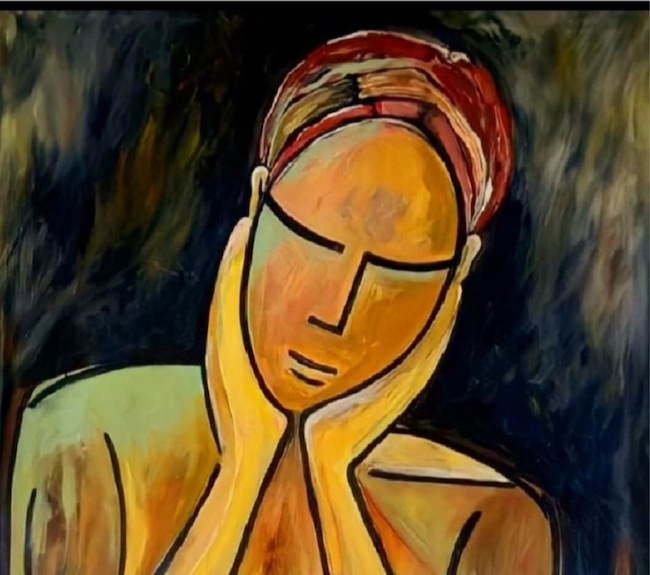Il senso della desolazione, lo smarrimento del vivere e l’isolamento in cui si trova l’uomo contemporaneo sono elementi frutto della ricerca pittorica di molti artisti attuali che necessitano compiere un percorso di esplorazione, di approfondimento sull’esistenza e sull’illusione di essere in un mondo globalizzato che in realtà lascia l’individuo solo, nascosto dietro la tecnologia apparentemente in grado di avvicinare e accorciare le distanze ma che in realtà provoca un profondo isolamento in cui il contatto umano, quello più reale, viene lasciato indietro. L’artista di cui vi racconterò oggi ritorna all’esplorazione delle angosce e delle inquietudini contemporanee attraverso una rappresentazione espressiva molto vicina a grandi maestri del Novecento.
Nel momento in cui il mondo si spingeva verso il progresso, verso un ripensamento della società in cui la classe operaia reclamava e otteneva maggiori diritti, in cui la superficialità della classe borghese cominciava a emergere con tutte le sue mancanze, e quando la prima guerra mondiale cominciò a distruggere certezze e punti di riferimento, anche l’arte subì un forte cambiamento per accordarsi a quelle sensazioni, per essere testimonianza delle emozioni profonde e di un nuovo contatto con un’interiorità ferita, spaventata, e proprio per questo bisognosa di fuoriuscire per interpretare un sentire comune. L’Espressionismo, che attinse alle linee guida dei Fauves modificandole e adattandole per trasformarsi in un vero e proprio movimento, sconvolse gli ambienti artistici degli inizi del Novecento, ancora legati a una pittura classica, accademica, che però non poté fare a meno di accogliere il nuovo stile come determinante per il percorso delle avanguardie e delle correnti successive che a quel primo passo si ispirarono. In particolar modo vi furono due grandi esponenti che cercavano l’essenza dell’individuo, sottolineando i suoi moti interiori letteralmente spogliando i loro protagonisti per indagare su quelle profondità che solo in virtù della ricerca pittorica potevano essere portati alla luce; i due maestri in questione furono l’italiano Amedeo Modigliani e l’austriaco Egon Schiele. Diversi nella modalità espressiva ma sicuramente entrambi attenti osservatori di tutto ciò che si muoveva all’interno dell’animo umano, Amedeo Modigliani più esteta e affascinato dalla figura femminile di cui ritraeva la delicatezza poetica così come la sensualità e le pulsioni che avvolgevano quei volti enigmatici e immobili in cui ciò che fuoriusciva era l’intensità dell’anima a discapito di una perfezione esteriore che non aveva più senso nell’epoca in cui viveva, mentre Egon Schiele più orientato a sottolineare le problematiche esistenziali dell’uomo, di cui la vera e unica salvezza sembrava essere la carnalità, la sessualità sempre presente perché in fondo era la percezione del sé più primordiale a permettere all’uomo dei primi decenni del Novecento di sopravvivere alle devastazioni della guerra, alle incertezze di un vivere in cui ogni giorno poteva significare morire; e dunque era proprio nell’abbraccio sensuale, nella nudità del corpo che i suoi personaggi potevano ritrovare se stessi, aggrappandosi gli uni agli altri per regalarsi un ultimo disperato momento di piacere. La medesima tematica della distorsione dei corpi, della nudità intesa come necessità di spogliarsi delle certezze per esplorare l’essenza senza timore di mostrare debolezze e fragilità, è stata ripresa molti anni dopo da uno dei maggiori esponenti della Scuola di Londra, Lucian Freud, nipote del padre della psicanalisi Sigmund, le cui grandi opere raffiguranti personaggi corpulenti e sdraiati su un letto o su un divano esprimevano il bisogno di andare a ricercare il rivolto psicologico, la natura reale dell’uomo e delle sue pulsioni più intime.
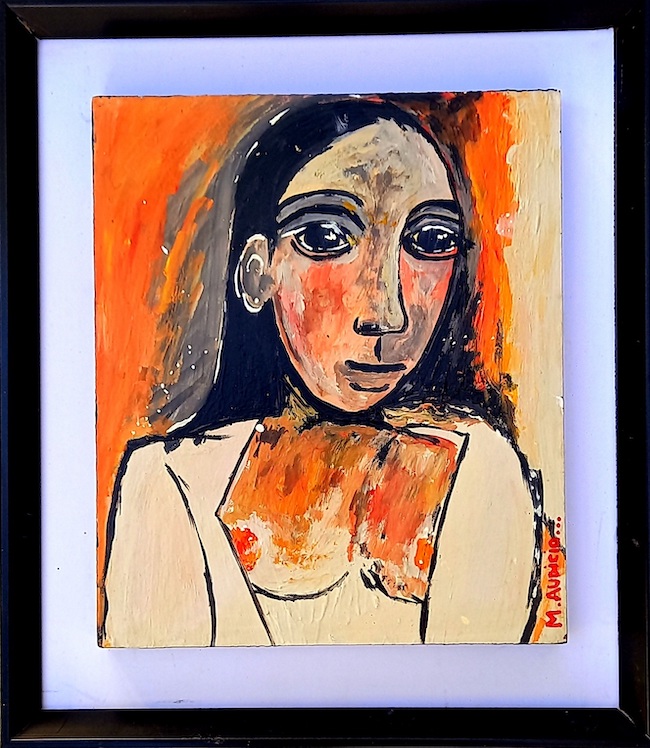
L’artista argentina Monica Audicio sembra compiere con la sua pittura una sintesi tra questi tre grandi artisti perché da un lato riprende il tema del corpo femminile come assoluto protagonista, come Amedeo Modigliani a cui si avvicina nella forma dei volti ispirata al Primitivismo che era stato base della ricerca espressiva di Modì, ma dall’altro va verso l’esplorazione interiore di Schiele che poneva al centro della sua opera l’inquietudine e l’incertezza del vivere.
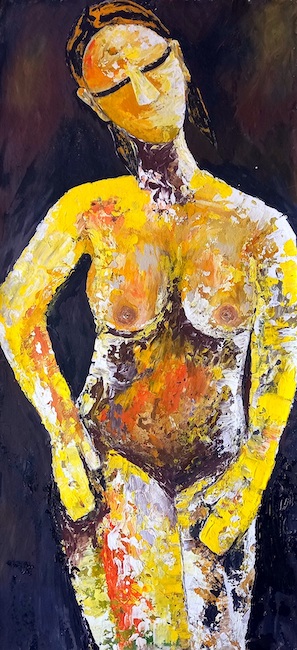
E infine imprime nelle sue protagoniste anche quel senso di approfondimento psicologico, le espressioni rubate in un frangente di debolezza, che caratterizzava le opere di Lucian Freud. La gamma cromatica delle opere della Audicio è irreale, impressa in modo rapido e impulsivo sulla tela, senza ritocchi volti a perfezionare ciò che, per lei, non deve essere migliorato bensì lasciato alla sua espressione iniziale, quella spontanea e immediata che fuoriesce dalla sua capacità empatica e dall’interazione che si attiva in lei quando si pone davanti al soggetto immortalato.
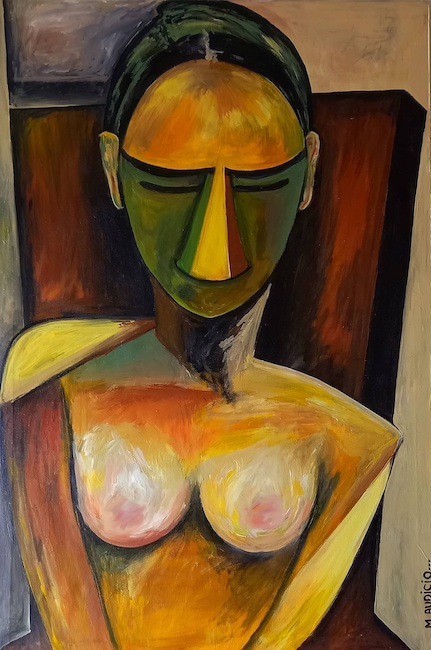
Ciò che le interessa non è tanto descrivere il volto, stilizzato e semplificato proprio alla maniera delle maschere africane che avevano ispirato sia l’Espressionismo di Modigliani che il primo Cubismo di Pablo Picasso, quanto lasciar parlare il corpo attraverso quel linguaggio silenzioso che non può essere nascosto, celato da un velo di menzogna, tutt’altro, può invece raccontare tutto il disagio e i timori che spesso a voce non si è in grado di rivelare.
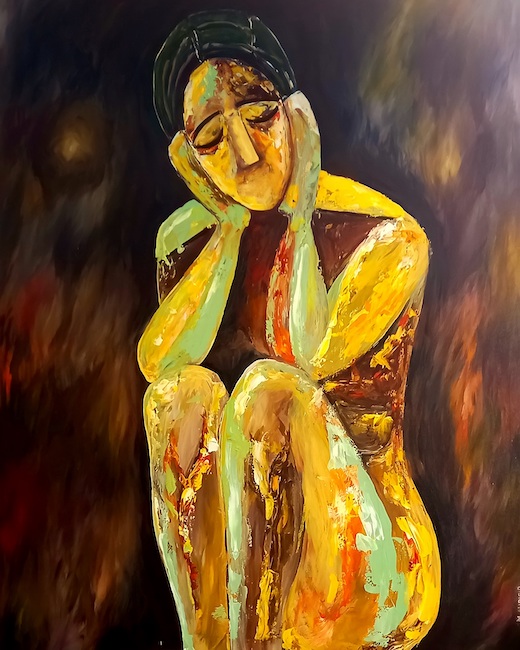
Nell’opera Tormento, la protagonista svela, attraverso il filtro espressivo di Monica Audicio che interpreta il sentire della donna, tutta l’angoscia, l’ansia per non essere stata in grado di trattenere a sé qualcuno di importante, rammaricandosi forse per non aver fatto tutto ciò che avrebbe potuto fare per cambiare il corso degli eventi, oppure al contrario, ricordando il frangente in cui pur essendo sicura di aver lottato con le unghie e con i denti ha visto comunque sfuggire via quanto in quel momento sembrava essere la cosa più preziosa. Malgrado i tratti del volto siano appena accennati non si può non cogliere il dolore che fuoriesce dall’arco delle sopracciglia, dagli occhi serrati a trattenere le lacrime, entrambi estensione dell’atteggiamento di chiusura del corpo, quasi volesse raccogliersi in se stesso per trovare conforto.
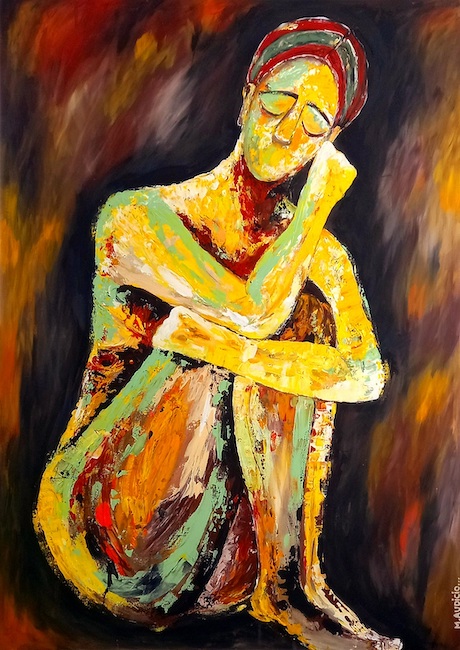
In Desolacion (Desolazione) allo stesso modo il viso contrito della protagonista esprime il senso di smarrimento, di pentimento generato da uno sbaglio che provoca a sua volta un rammarico con cui è necessario fare i conti, malgrado tutto, ed è proprio questa la sensazione che emerge dalla tela, quella di presa di coscienza degli eventi che non possono essere cambiati bensì solo accettati con tutte le conseguenze che hanno portato con sé. La gamma cromatica è in quest’opera più positiva, meno cupa rispetto alla precedente perché in questo caso gli accadimenti non sono stati subiti bensì in qualche modo provocati dalla donna che, consapevolmente, accetta quel senso di solitudine che scaturisce nel momento in cui diventa necessario effettuare un percorso introspettivo di esplorazione dei risvolti che ne sono derivati.
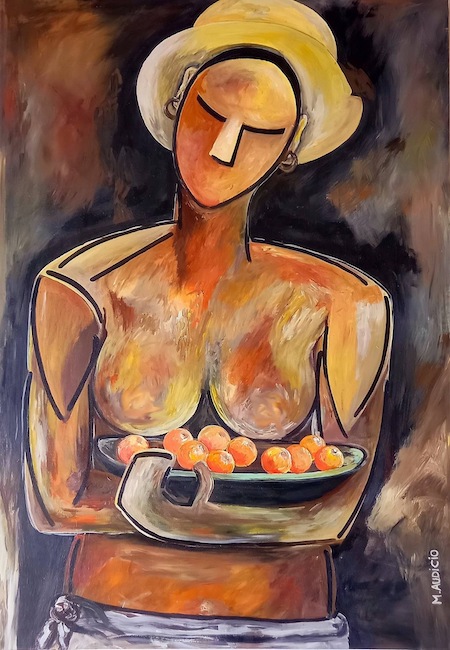
La complessità del vivere contemporaneo, sembra suggerire Monica Audicio, può essere superata e vinta solo attraverso un ritorno alla semplicità, alla naturalezza che appartiene all’uomo e che viene ritrovata recuperando un atteggiamento volto ad apprezzare le piccole cose, quei momenti belli ma spesso distrattamente inosservati che invece sono in grado di cambiare tutto il punto di vista; è questo ciò che emerge dal dipinto Cali, in cui la donna colombiana appare nella sua semplicità di costumi, quel vivere libera tipico delle comunità rurali del suo paese senza altra preoccupazione che non sia quella di pensare al sostentamento suo e della sua famiglia, offrendo un sorriso e della frutta allo straniero che attraversa la sua terra. C’è serenità in questa opera, non c’è afflizione bensì solo la piacevolezza del lasciarsi andare a tutto ciò che la vita offre, senza volere di più perché in fondo può non essere necessario.
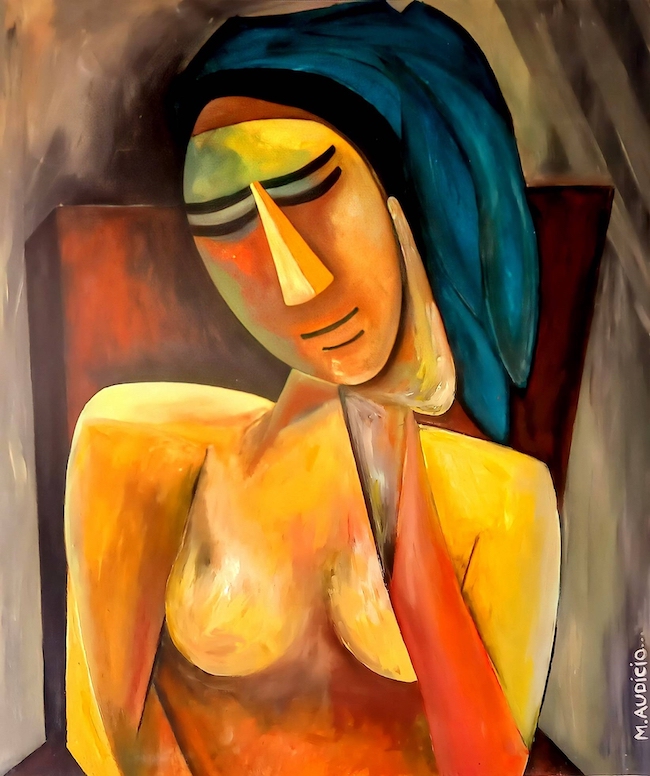
La medesima sensazione è quella che si percepisce osservando la tela Ona, in cui la Audicio mette in evidenza la spontaneità, quell’essere in naturale connessione con la propria interiorità che diviene dunque equilibrio per affrontare i continui alti e bassi a cui la vita sottopone l’essere umano; la donna appare tranquilla, a suo agio, quasi come se un episodio appena accaduto le regalasse quell’aspetto disteso e sorridente, come se fosse certa di aver assaporato ogni istante con cui ha avuto l’opportunità di misurarsi. Ed è forse questo il segreto, l’essenza stessa della vita. Monica Audicio espone regolarmente in Argentina e in vari paesi del mondo, sia in mostre virtuali che fisiche, ricevendo premi e attestati, e incontrando l’approvazione del pubblico e degli addetti ai lavori.
MONICA AUDICIO-CONTATTI
Email: moniaudicio@gmail.com
Facebook: https://www.facebook.com/monica.audicio.9
https://www.facebook.com/MonicaAudicio/
Instagram: https://www.instagram.com/monicaaudicio/
Monica Audicio’s Expressionism, between a sense of solitude and reflection on the essence of life
The sense of desolation, the bewilderment of living and the isolation in which contemporary man finds himself are elements which are fruit of the pictorial research of many contemporary artists who need to explore, to examine existence and the illusion of being in a globalised world which in reality leaves the individual alone, hidden behind technology apparently capable of bringing people closer and shortening distances but which in reality provokes a profound isolation where human contact, the most real one, is left behind. The artist I am going to tell you about today returns to the exploration of contemporary anxieties and concerns through an expressive representation very close to the great masters of the 20th century.
At a time when the world was moving towards progress, towards a rethinking of society where the working class was claiming and obtaining greater rights, in which the superficiality of the bourgeois class was beginning to emerge with all its shortcomings, and when the First World War began to destroy certainties and points of reference, art too underwent a major change in order to tune in to those sensations, to bear witness to deep emotions and a new contact with a wounded, frightened interiority, and for this very reason in need of escape to interpret a common feeling. Expressionism, which drew on the guidelines of the Fauves modifying and adapting them to become a real movement, upset the artistic circles of the early 20th century, that were still tied to classical, academic painting, but which could not fail to accept the new style so decisive for the path of the avant-gardes and subsequent currents that were inspired by that first step. In particular, there were two great exponents who sought the essence of the individual, emphasising their inner movements by literally stripping their protagonists bare to investigate those depths that could only be brought to light by virtue of pictorial research; the two masters in question were the Italian Amedeo Modigliani and the Austrian Egon Schiele.
They differed in their modes of expression but both were certainly attentive observers of everything that moved within the human soul, Amedeo Modigliani was more aesthete and fascinated by the female figure, portraying the poetic delicacy as well as the sensuality and impulses that enveloped those enigmatic, immobile faces in which what emerged was the intensity of the soul, to the detriment of an exterior perfection that no longer made sense in the era in which he lived, while Egon Schiele was more oriented towards underlining the existential problems of man, whose true and only salvation seemed to be his carnality, his ever-present sexuality, because after all it was the perception of the most primordial self that allowed man in the first decades of the twentieth century to survive the devastation of war, the uncertainties of a life in which every day could mean death; and so it was precisely in the sensual embrace, in the nakedness of the body, that his characters could find themselves, clinging to each other to give themselves one last desperate moment of pleasure. The same theme of the distortion of bodies, of nudity intended as the need to strip away certainties in order to explore the essence without fear of showing weaknesses and fragility, was taken up many years later by one of the leading exponents of the School of London, Lucian Freud, grandson of the father of psychoanalysis Sigmund, whose large artworks depicting corpulent characters lying on a bed or a sofa expressed the need to go in search of the psychological aspect, the real nature of man and his most intimate impulses. Argentine artist Monica Audicio’s painting seems to be a synthesis of these three great artists, because on the one hand she takes up the theme of the female body as the absolute protagonist, like Amedeo Modigliani to whom she comes close in the shape of faces inspired by Primitivism, which had been the basis of Modì’s expressive research, but on the other hand she goes towards the interior exploration of Schiele, who placed the restlessness and uncertainty of life at the centre of his artworks. And finally she also imprints on her protagonists that sense of psychological insight, expressions stolen in a moment of weakness, which characterised the works of Lucian Freud.
The chromatic range of Audicio’s paintings is unreal, imprinted quickly and impulsively on the canvas, without retouches aimed at perfecting what, for her, should not be improved but left to its initial expression, the spontaneous and immediate one that emerges from her empathic capacity and the interaction that is triggered in her when she stands in front of the immortalised subject. What interests her is not so much describing the face, stylised and simplified in the manner of the African masks that had inspired both Modigliani’s Expressionism and Pablo Picasso’s early Cubism, as letting the body speak through that silent language that cannot be hidden, concealed by a veil of lies; on the contrary, it can recount all the unease and fears that often cannot be revealed verbally. In Tormento, the protagonist reveals, through the expressive filter of Monica Audicio, who interprets the woman’s feelings, all her anguish and anxiety at not having been able to keep someone important to herself, perhaps regretting not having done all she could have done to change the course of events, or on the contrary, remembering the moment when, although she was sure she had fought tooth and nail, she saw the most precious thing at that moment slip away. Although her facial features are barely visible, one cannot help but notice the pain that comes out of the arch of her eyebrows and her eyes, which are closed to hold back tears, both of which are an extension of the closed attitude of her body, as if she wanted to withdraw into herself to find comfort.
In Desolacion (Desolation), in the same way, the protagonist’s contrite face expresses the sense of loss, of repentance generated by a mistake that in turn provokes a regret that must be come to terms with, despite everything, and this is precisely the sensation that emerges from the canvas, that of awareness of events that cannot be changed but only accepted with all the consequences they have brought with them. The range of colours in this artwork is more positive, less gloomy than in the previous one, because in this case the events have not been suffered but in some way provoked by the woman who consciously accepts the sense of solitude that arises when it becomes necessary to undertake an introspective journey of exploration of the consequences. The complexity of contemporary life, Monica Audicio seems to suggest, can only be overcome and won through a return to simplicity, to the naturalness that belongs to man and that is rediscovered by recovering an attitude aimed at appreciating the small things, those beautiful but often distractedly unnoticed moments that are instead capable of changing the whole point of view; this is what emerges from the painting Cali, in which the Colombian woman appears in the simplicity of her customs, that free life typical of the rural communities of her country, with no other concern than that of supporting herself and her family, offering a smile and some fruit to the stranger passing through her land. There is serenity in this canva, there is no affliction but only the pleasure of letting oneself go to all that life offers, without wanting more because after all it may not be necessary. The same sensation can be perceived when observing the canvas Ona, in which Audicio highlights spontaneity, that being in natural connection with one’s own interiority which thus becomes a balance for facing the continuous ups and downs to which life subjects the human being; the woman appears calm, at ease, almost as if an episode that has just happened gave her that relaxed and smiling aspect, as if she were certain of having savoured every moment with which she had the opportunity to measure herself. And perhaps this is the secret, the very essence of life. Monica Audicio regularly exhibits in Argentina and in various countries around the world, both in virtual and physical exhibitions, receiving awards and certificates, and meeting with the approval of the public and professionals.


